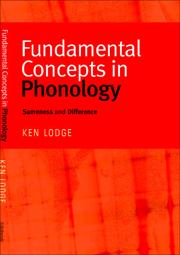Book contents
1 - The notions of sameness and difference
Published online by Cambridge University Press: 05 August 2013
Summary
Human beings classify the world around them. This classification occurs through language, which has led some linguists to go so far as to argue for linguistic determinism (Sapir, Whorf, Halliday). Whatever the merits and demerits of such a functional approach to the forms of language, as far as the human classification of the world (and beyond) is concerned, the development of a scientific account of reality has made the notions of sameness and difference central to such exploration. If x is considered ‘the same as’ y in certain respects, then x and y belong to the same category. If x is considered ‘different’ from y, then they belong to different categories. I want to consider these notions briefly in some other disciplines before going on to consider them and related concepts in the rest of the book within phonology.
I shall start, therefore, by taking a handful of instances to see the relevance of the arguments surrounding what counts as the same for areas outside linguistics and to see whether there are consistently applied criteria for helping the investigators to come to a conclusion about classification in any particular case. I will look at chemical formulae, aspects of mammalian biology, music and visual representation.
- Type
- Chapter
- Information
- Fundamental Concepts in PhonologySameness and Difference, pp. 1 - 13Publisher: Edinburgh University PressPrint publication year: 2009



